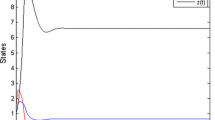Abstract
In this article, we study the dynamical behavior of polar bear preying on ringed and bearded seals. Stochastic non-autonomous Holling type-III two-prey one-predator model is formulated with harvesting in prey species and intra-specific competition among predators. The growth rates and harvesting terms of the system have been perturbed with white noise. Effect of climate change on growth rates of the species has been considered here. At first, feasibility of the model system has been established by the existence of global positive solution. Then sufficient conditions for extinction, non-persistence in mean, weakly persistence in mean and permanence of the populations are demonstrated. Theoretical results are verified numerically. Finally, ecological interpretations are given in the concluding section.






Similar content being viewed by others
References
World Wildlife Fund. https://www.worldwildlife.org/species/polar-bear. Accessed 9 Mar 2019
World Wildlife Fund. https://www.worldwildlife.org/species/seals. Accessed 9 Mar 2019
Gretchko, S., Marley, J., Tyson, R.C.: The Effects of Climate Change on Predator-Prey Dynamics. (2018) https://arxiv.org/abs/1805.11816v1
Banerjee, R., Das, P., Mukherjee, D.: Stability and permanence of a discrete-time two-prey one-predator system with Holling type-III functional response. Chaos Solitons Fractals (2018). https://doi.org/10.1016/j.chaos.2018.10.032
Chatterjee, A., Pal, S., Venturino, E.: A plankton-nutrient model with Holling type III response function. In: Mondaini, R. (ed.) Trends in Biomathematics: Modeling, Optimization and Computational Problems. Springer, Cham (2018). https://doi.org/10.1007/978-3-319-91092-5_12
Sea World parks and entertainment. https://seaworld.org/animals/all-about/polar-bear/diet/. Accessed 9 Mar 2019
May, R.M.: Stability and Complexity in Model Ecosystems. Princeton University Press, Princeton (2001)
Schwarz, M., Godec, A., Oshanin, G., Metzler, R.: A single predator charging a herd of prey: effects of self volume and predator–prey decision-making. J. Phys. A Math. Theor. 49, 225601 (2016)
Ryu, K., Ko, W., Haque, M.: Bifurcation analysis in a predator–prey system with a functional response increasing in both predator and prey densities. Nonlinear Dyn 94, 1639 (2018)
Liu, M.: Dynamics of a stochastic regime-switching predator–prey model with modified Leslie–Gower Holling-type II schemes and prey harvesting. Nonlinear Dyn. (2019). https://doi.org/10.1007/s11071-019-04797-x
Ghosh, P., Das, P., Mukherjee, D.: Persistence and stability of a seasonally perturbed three species stochastic model of salmonoid aquaculture. Differ. Equ. Dyn. Syst. (2016). https://doi.org/10.1007/s12591-016-0283-0
Shuang, L., Xinan, Z.: Dynamics of a stochastic non-autonomous predator–prey system with Beddington–DeAngelis functional response. Adv. Differ. Equ. (2013). https://doi.org/10.1186/1687-1847-2013-19
Zhang, Y., Chen, S., Gao, S.: Analysis of a nonautonomous stochastic predator–prey model with Crowley–Martin functional response. Adv. Differ. Equ. (2016). https://doi.org/10.1186/s13662-016-0993-1
Sengupta, S., Das, P., Mukherjee, D.: Stochastic non-autonomous Holling type-III prey–predator model with Predator’s intra-specific competition. Discrete Continuous Dyn. Syst. Ser. B 23(8), 3275–3296 (2018)
Mao, X.Y.: Stochastic Differential Equations and Applications. Horwood Publishing Limited, Chichester (2018)
Mao, X., Yuan, C.: Stochastic Differential Equations with Markovian Switching. Imperial College Press, London (2006)
Li, X.Y.: Population dynamical behavior of non-autonomous Lotka–Volterra competitive system with random perturbation. Discrete Contin. Dyn. Syst. 24, 523–545 (2009)
Liu, M., Wang, K., Wu, Q.: Survival analysis of stochastic competitive models in a polluted environment and stochastic competitive exclusion principle. Bull. Math. Biol. 73, 1969–2012 (2011)
Liu, M., Wang, K.: Persistence, extinction and global asymptotical stability of a non-autonomous predator–prey model with random perturbation. Appl. Math. Model. 36, 5344–53 (2012)
Higham, D.: An algorithmic introduction to numerical simulation of stochastic differential equations. SIAM Rev. 43, 525–546 (2001)
Author information
Authors and Affiliations
Corresponding author
Ethics declarations
Conflict of interest
The authors declare that they have no conflict of interest.
Additional information
Publisher's Note
Springer Nature remains neutral with regard to jurisdictional claims in published maps and institutional affiliations.
Rights and permissions
About this article
Cite this article
Sengupta, S., Das, P. Dynamics of two-prey one-predator non-autonomous type-III stochastic model with effect of climate change and harvesting. Nonlinear Dyn 97, 2777–2798 (2019). https://doi.org/10.1007/s11071-019-05163-7
Received:
Accepted:
Published:
Issue Date:
DOI: https://doi.org/10.1007/s11071-019-05163-7




